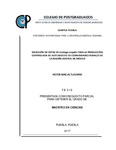| dc.description.abstract | La producción de huitlacoche cuenta con técnicas bien fundadas para la infección de maíz con el hongo Ustilago maydis, sin embargo, la infección no siempre se lleva de la misma forma, dando como resultado variaciones en el desarrollo del hongo. En el presente trabajo se aislaron cepas patogénicas y solopatogénicas nativas de la región de Cholula, Puebla. Se estandarizó el aislamiento de esporidias mediante la técnica de microdiluciones, y de 20 esporidias nativas, se realizaron 190 cruzas, de las cuales 12 cruzas positivas se lograron con las esporidias: e12, e14, e16, e18, e22, e24 y e25, y 37 cruzas correspondieron a las esporidias e7 y e11. Se seleccionaron las esporidias e2, e7, e11, e14, e18 y e21, las cuales se entrecruzaron con las cepas de referencia CP-436 y CP-437. Se ubicaron en sus clases de compatibilidad, la e2 y e14 en la clase I, y e18 y e21 de la clase II. También se estandarizó la elaboración del inóculo mediante el conteo de esporidias por densidad óptica y recuento celular, los resultados se sometieron a una matriz de correlación de Pearson en el programa SAS. Se analizaron las variables concentración contra absorbancia, arrojando una correlación de 0.85, en una concentración de 1x106 esporidias•mL-1. Finalmente, se probaron las cepas seleccionadas infectando plántulas de maíz de la variedad Hue-CP-14, seleccionada por su rápido ciclo (74 días de floración masculina y 81 días de floración femenina). No se encontró efecto significativo por la fuente de variación “variedad” y caracterización de 2 ciclos de cultivo de maíz bajo invernadero. Las esporidias e7 y e11 son cepas infectivas heterocarióticas, que formaron agallas a los 7 días después de la infección. Los híbridos infectivos CP-436xe7, CP-437xe7, CP-437xe11, CP-437xe14, e7xe11 y CP-436xCP-437, evidenciaron la aparición de infección a los 14 días en promedio, después de la inoculación. _______________ SELECTION OF Ustilago maydis STRAINS FOR CONTROLLED PRODUCTION OF HUITLACOCHE IN RURAL COMMUNITIES IN THE CENTRAL REGION OF MÉXICO. ABSTRACT: The production of huitlacoche has well-founded techniques for the infection of corn with the fungus Ustilago maydis, however, the infection is not always carried in the same way, resulting in variations in the development of the fungus. In the present work, pathogenic and single pathogenic strains were isolated from the Cholula region, Puebla. Isolation of sporidia was standardized using the microdilution technique, and of 20 native sporidia, 190 crosses were made, of which 12 positive crosses were achieved with the sporidia: e12, e14, e16, e18, e22, e24 and e25, and 37 crosses corresponded to the sporidia e7 and e11. The sporidia e2, e7, e11, e14, e18 and e21 were selected, which were cross-linked with the reference strains CP-436 and CP-437. They were located in their compatibility classes, e2 and e14 in class I, and e18 and e21 in class II. We also standardized the preparation of the inoculum by counting sporidia by optical density and cell count, the results were subjected to a Pearson correlation matrix in the SAS program. The concentration against absorbance variables were analyzed, yielding a correlation of 0.85, at a concentration of 1x106 sporidia•mL-1. Finally, the selected strains were tested by infecting maize seedlings of the Hue-CP-14 variety, selected for its rapid cycle (74 days of male flowering and 81 days of female flowering). No significant effect was found by the source of variation "variety" and characterization of 2 cycles of corn cultivation under greenhouse. The sporidia e7 and e11 are heterokaryotic infective strains, which formed galls 7 days after infection. The infective hybrids CP-436xe7, CP-437xe7, CP-437xe11, CP-437xe14, e7xe11 and CP-436xCP-437, showed the appearance of infection at 14 days on average, after inoculation. | es_MX |


